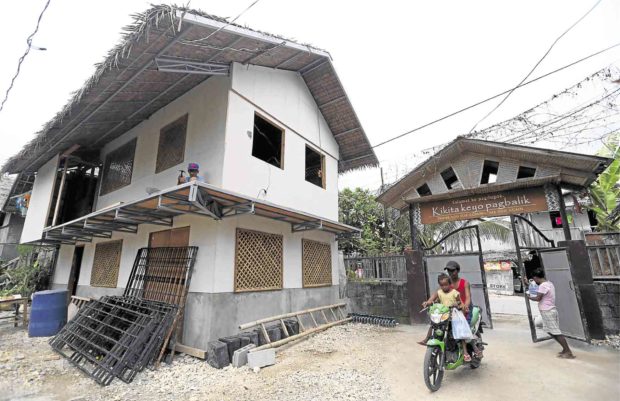
TRIBAL VILLAGE At least 45 Ati families on Boracay Island live in a 2.1-hectare ancestral land awarded to them by the government in 2011. —LYN RILLON
The Ati tribe of Boracay Island wants any additional land awarded to them by the government to be covered under an ancestral domain title, instead of individual titles as agrarian reform beneficiaries.
In a resolution passed by the Boracay Ati Tribe Organization (Bato) on June 13, tribe members expressed gratitude to President Duterte for his pronouncements that a significant portion of land on the 1,032-hectare island will be subjected to land reform and distributed to them.
But they asked that the land be covered by a Certificate of Ancestral Domain Title (CADT), which is issued by the National Commission on Indigenous Peoples (NCIP), instead of a Certificate of Land Ownership Award (Cloa) issued by the Department of Agrarian Reform (DAR), according to Evangeline Tambuon, Bato council member.
Community property
Land covered by a CADT is considered a community property of indigenous peoples’ groups or community and succeeding generations. This cannot be destroyed, sold or disposed of.
Land covered by Cloa, on the other hand, can be disposed of or awarded after 10 years, according to the DAR.
The government, through the NCIP, issued in 2011 a CADT to the tribe covering a 2.1-hectare beach front property in Barangay Manoc-Manoc, one of three villages of Boracay.
The community occupies only a portion of the CADT-covered property due to ownership disputes.
The DAR earlier announced that the government plans to distribute 868 ha out of the 1,032-ha island for agrarian reform based on the President Duterte’s directive. Boracay had been closed to tourists to give way to a six-month rehabilitation starting April 26.
DAR officials said they were ready to implement the land reform program by covering 25 hectares, which is about 2 percent of the island’s land area, in the first phase of the program.
They also revealed their plan to revert lands in Boracay suitable for agriculture by dumping topsoil on developed portions.
Tambuon said they would welcome the expansion of the tribe’s CADT-covered land even as their primary concern was the occupation of the whole 2.1 ha.
The President had said that the Ati tribe had the option to sell land awarded to them to investors so they could earn from the economic development of the island.
Smoke screen
But farmers’ groups on Panay Island criticized the DAR for its insistence to subject the whole island to agrarian reform.
“Agrarian reform is just a smoke screen for the real intention, which is to [grab] land … and give it, on a silver platter, to big investors,” said Cris Chavez, secretary general of the Paghugpong sang mga Mangunguma sa Panay kag Guimaras (Alliance of Farmers in Panay and Guimaras).
On Monday, Agrarian Reform Secretary John Castriciones defended Mr. Duterte over his plan to allow land reform beneficiaries to sell their lands.
Castriciones said the President was within his authority to decide on the government’s agrarian reform program for Boracay, even without the prior concurrence of the Presidential Agrarian Reform Council.
He expected the agrarian reform program in Boracay to face legal obstacles, mainly over tracts of land with existing structures and claimants.